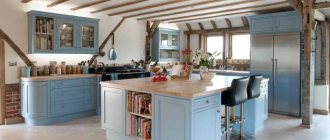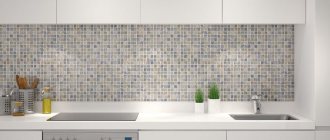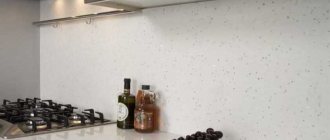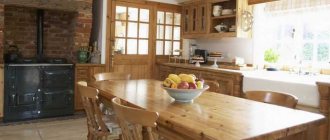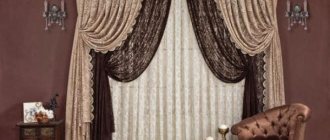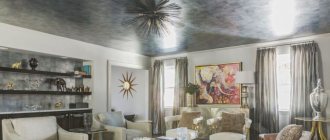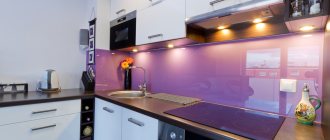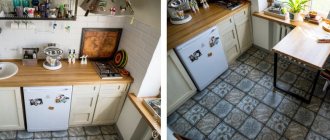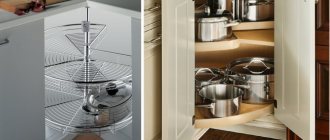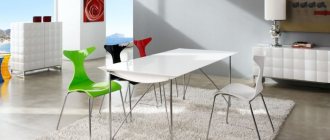Requirements for apron material
When choosing modules in the catalog of kitchen aprons, you should pay attention to the characteristics of the selected material. The basis for creating a protective coating over the hob must meet a number of requirements:
- Strength of the material. The strong structure gives the material resistance to mechanical deformation.
- Moisture resistant. The presence of an apron requires frequent cleaning of the work area, and therefore the coating should not be afraid of moisture.
- High temperature resistance. The heat from the hob can damage some of the materials used to create backsplashes.
In addition, they pay attention to the appearance, presence of decor and environmental indicators. The manufacturing technology should not use toxic or flammable varnishes and paints.
Types of materials for the production of kitchen aprons
The performance and external qualities of a kitchen apron depend on the material from which it is made. It could be:
- plastic;
- ceramics;
- glass;
- natural or artificial stone;
- tree;
- metal;
- Chipboard or MDF.
Plastic panels for kitchen apron
Plastic kitchen panels are made from solid polyvinyl chloride. They have a hollow honeycomb structure, which provides additional heat and sound insulation.
The advantages of this material include:
- ease of installation and maintenance;
- a light weight;
- affordable price;
- durability.
However, plastic is vulnerable to mechanical stress, is resistant to abrasive detergents and caustic chemicals, and can also melt if overheated.
Kitchen apron made of ceramic tiles
Ceramic tiles or mosaics are one of the most popular design options for kitchen backsplashes. It has become widespread due to its favorable combination of high quality and affordable cost.
The advantages of ceramic coating include:
- durability;
- external attractiveness;
- resistance to moisture and mechanical stress.
The only difficulty is that to install such tiles you will need a special stable putty.
Glass Kitchen Wall Panels
Glass protective panels are called skinali. They have the following advantages:
- resistant to scratches and impacts;
- have a perfectly smooth surface on which dirt does not accumulate;
- easy to clean;
- provide the headset with a stylish appearance.
High-quality glass is not cheap, and not all types can withstand temperature changes. Therefore, such a design should be chosen with particular care.
Stone kitchen apron
A stone apron looks much more refined and aristocratic than a ceramic tile coating and at the same time has high characteristics:
- not afraid of temperature changes;
- not susceptible to the formation of fungus and mold;
- easy to restore - the damaged surface can simply be sanded.
Natural stone panels are very expensive and heavy, so most often they are replaced with more affordable, but no less practical and attractive slabs made of artificial material. This can be decorative concrete, porcelain stoneware and various types of composites (mixtures of natural stone filler and polyester resins).
Wooden apron for kitchen set
Wood is the most expensive material used for the production of kitchen aprons. Fine maple, cedar, alder or oak are coated with special wax, which protects the panel from swelling and deformation.
Despite the fact that a wooden apron looks elegant, it is rarely used in the kitchen due to its high cost.
Metal kitchen apron
The metal apron is durable, not subject to any aggressive influences, but has only two textures - glossy and matte. It is ideal for minimalist or high-tech kitchens. Unfortunately, it will not look entirely appropriate in other styles.
Kitchen wall panels made of chipboard and MDF
Chipboard or MDF are materials made from wood shavings. Simply put, wood processing waste.
Chipboard uses toxic synthetic substances for gluing, so it is not environmentally friendly and does not have high performance characteristics.
Natural resins are used in the production of MDF, which makes it a safe and reliable material.
Kitchen panels made of chipboard are laminated and look attractive, but cannot boast of strength and are not resistant to high temperatures and water.
Products made from MDF, on the contrary, are durable and can be used even in conditions of high humidity, but are more expensive.
Material for creating an apron
Today, any buyer has the opportunity to first familiarize himself with a photo of a kitchen apron, its main materials and properties. In construction supply stores, each client will be offered a huge range of products: any color and composition, texture and cost. The most common options are:
- Ceramic tile.
- Tempered glass modules.
- Plastic panels.
- MDF panels.
- Artificial or natural stone.
- Mirror panels.
- Mosaic covering.
It is worth noting! Gypsum panels or decorative plaster are very rarely used. Such materials can decorate any room, but they do not meet the requirements. Plaster and gypsum stucco are used only for decorative kitchen or dining areas.
Aprons made of tiles and porcelain stoneware
Perhaps the most common finishing option is tile.
Designers prefer this option to others, since the material is durable, has all the necessary protective qualities, is easy to care for, and the variety of color and shape palettes allows you to correctly fit the resulting panel into any interior.
Ceramic tile
Kitchen backsplash tiles are the best option for any interior style. A huge selection of materials differing in color, decor, shape, size and texture. In a hardware store you can find a kitchen model in a wide price range. Tiled modules are quite durable and resistant to moisture and elevated temperatures. It is easy to carry out wet cleaning and remove any types of dirt.
Ceramics are non-toxic and not dangerous to others. Due to its structure, it does not absorb unpleasant odors, and the appearance does not deteriorate during operation.
Glass aprons
This material is ideal for this type of finishing.
Glass aprons for the kitchen are heat-resistant, resistant to household chemicals, last for decades, allow you to implement even the most daring design ideas, do not emit harmful substances and do not absorb odors.
Against the background of these advantages, minor disadvantages such as heavy weight and high price become insignificant.
Plastic panels for kitchen
Kitchen aprons made of plastic are used quite often. The material is affordable and comes in a wide variety of colors and textures. The smooth surface and moisture resistance allow for wet cleaning as needed. The disadvantage of the practical use of a plastic apron for the kitchen is that the coating is easy to scratch, and some types of dirt cannot be erased.
Geometric tiles
An apron in the kitchen should be stylish, durable and match the style of the interior. Geometric tiles are one of the most popular examples of finishing today. And it is no coincidence: it is easy to clean, resistant to alkalis and acids, does not absorb fat, and does not react to sudden changes in temperature and humidity. Let's look at the most attractive ideas.
Apron made of MDF panels
The advantages of using this material are:
- Decorative appearance.
- Natural materials.
- Easy to install the coating with your own hands.
- Relatively low cost of material.
Unfortunately, in some respects, an MDF kitchen apron is inferior to all previous coatings:
- High humidity and high temperatures negatively affect the appearance of the coating. During operation, the material will lose its original original appearance.
- Due to the porous structure, the panels absorb odors, and greasy deposits and soot can eat into the surface layers of the material.
A significant plus is that the panels are easy to replace (they do not require preliminary leveling of the walls, and the price is affordable for the buyer).
Kitchen apron made of MDF and wood
Such models cannot be called an ideal option for the kitchen, since the material itself is capable of absorbing dirt, odors and moisture. However, for some, environmental friendliness of wood becomes a mandatory component of kitchen design. In this case, the coating must be pre-treated with special oils and varnish. A wooden apron can become part of any style. It can be combined with other kitchen elements. MDF aprons are becoming a more affordable option.
Mirror panels for apron
To decorate the apron above the hob, you can also use mirror panels, which are durable and have a pleasant appearance. Thanks to glossy tints and original colors, they “refresh” the interior and highlight the decor of the kitchen set.
In addition, it has a smooth surface that is very easy to clean. The coating is resistant to moisture and chemicals (detergents), which greatly facilitates the cleaning process.
How to choose?
When purchasing a glass apron, you are buying not so much a thing as a service, since the appearance of the finished area will depend entirely on the quality of measurements and installation.
A company representative makes all the necessary measurements and calculations after installing the kitchen furniture. He also evaluates the wall material and selects the appropriate type of fastening.
Glass panels are made from thick tempered glass. The larger the elements, the higher their cost - the complexity of installation increases.
Installation of a kitchen apron
The decision on the method of installation of the coating depends on the selected material:
- For coverings such as stone, decorative shawls or mosaic structures, you will need more than just the help of a specialist. In this case, a mandatory stage of repair work will be leveling and plastering the walls.
- For plastic panels, MDF and some types of tiles, pre-treatment is not required.
In other cases, the amount of preparatory work will depend on the quality of the wall coverings, the presence of construction defects, as well as the presence or absence of a complex pattern on the apron.
The apron above the hob is an extremely important element of the kitchen interior. Decorative coating not only performs a practical function, but also plays an aesthetic role, emphasizing the features of the style.
Recommendations for designing a kitchen apron
The main task of a kitchen apron is to protect the wall and furniture from high temperatures, water, steam and grease splashes. Therefore, when choosing a finishing material, you need to take into account its main characteristics. Over time, it should not deform, and caring for such an apron should not be burdensome.
Despite the fact that some designers finish the entire wall, the apron still stands out separately. And thanks to color, pattern or texture, it becomes a bright detail. To make the space harmonious, it can be made of the same material as the countertop.
A dark surface is considered impractical. But if you still decide to make the apron rich, you need to “tone down” the rest of the kitchen. To visually lengthen a room, use horizontal stripes. A mirror surface will make the kitchen more voluminous.
To make the food here look more appetizing, experts recommend using warm shades.
